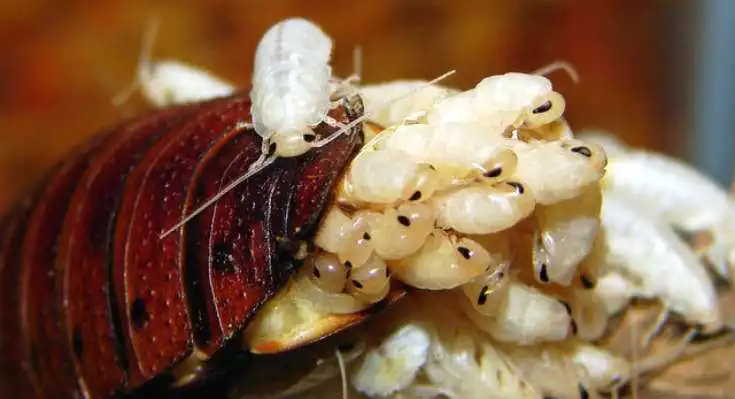Most of us know the feeling of dread that comes when we spot a cockroach scurrying across the floor. Among the most hated of all household pests, the cockroach is more than just an unwanted house guest. Experts at hiding their nests and fast runners, cockroaches can go undetected for weeks. Too often, by the time baby cockroaches are spotted crawling in the house, there is a much larger infestation already in the works. What’s worse, is cockroaches – even baby roaches – can carry dangerous diseases and allergens. This is why it is important to know what baby cockroaches look like!
They are also notoriously difficult to eradicate. An important step in identifying a roach problem before it becomes a full-blown infestation is knowing what baby roaches look like. Understanding their breeding and eating habits can also help protect households from cockroach invasion.
What Do Baby Roaches Look Like?
Baby roaches are called nymphs. Depending on what species they are, they can be white or gray when they are babies. The younger they are, the lighter they will be. Baby roaches are usually white right after they hatch from an egg and then darken as they age. Some nymph cockroaches can have wings or stripes. Juvenile roaches that are not nymphs, but are not yet fully mature, may just look like miniature versions of adult roaches.
It is not a good sign if baby roaches are present in a home because it means there is probably a nest somewhere in the house which contains even more of these pests. Female cockroaches lay multiple eggs at a time, so if one baby is present, it is likely that other babies are present, as well.
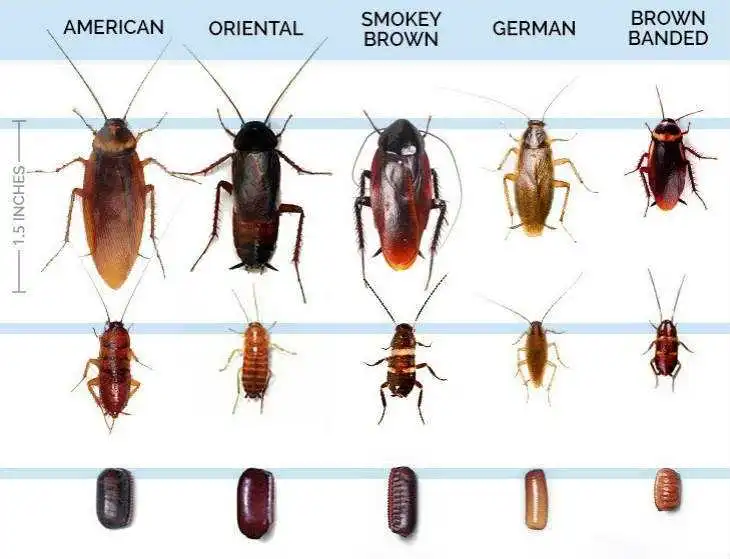
How to Identify Young Cockroaches: Pictures of Baby Roaches
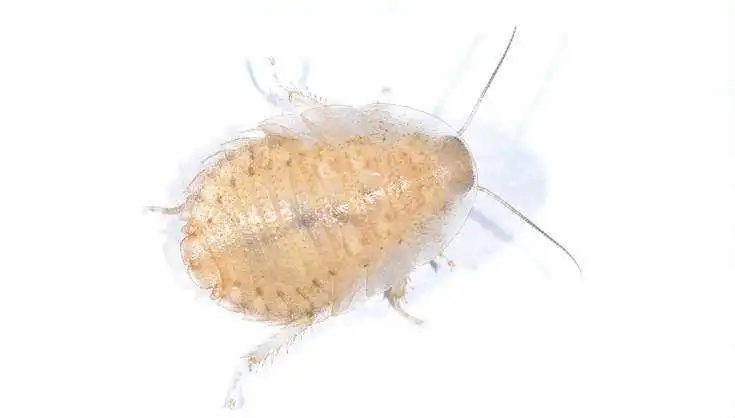
White nymphs are newly hatched from their eggs. Depending on their species, they may mature with in 3 months or 2 years.
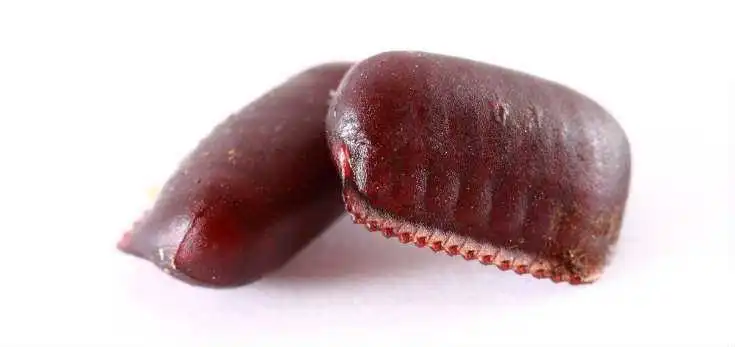
Female roaches lay ootheca, which are cases that contain between 10 and 50 eggs, depending on the roach’s species.
What is ootheca?
Ootheca is the egg case of cockroaches, mantises, and related insects. One ootheca can contain multiple eggs. Numbers of eggs contained in an ootheca will depend on the cockroach species but may contain up to 50 eggs.
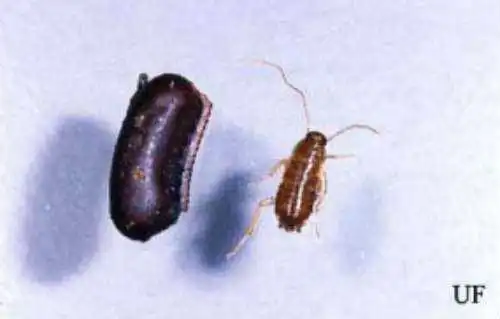
Juvenile roaches may look like miniature versions of an adult cockroach.
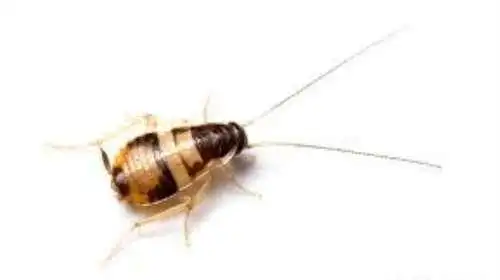
Brown-banded roach nymphs are identified by a yellow band on their abdomens.
German cockroaches are darker in color and can reproduce at very rapid rates. Each ootheca can contain up to 50 eggs.
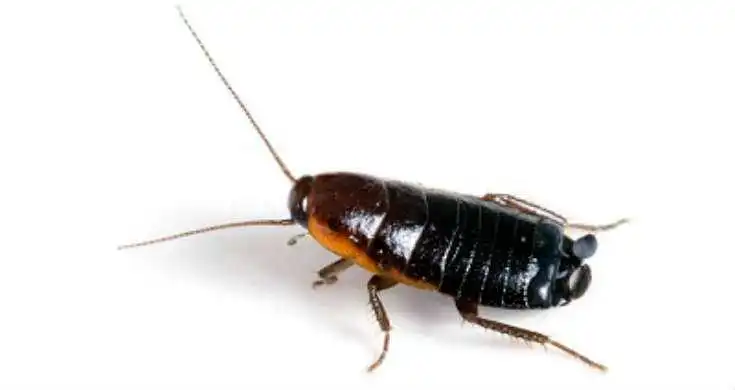
Oriental roach nymphs can be black and are larger than German cockroaches.
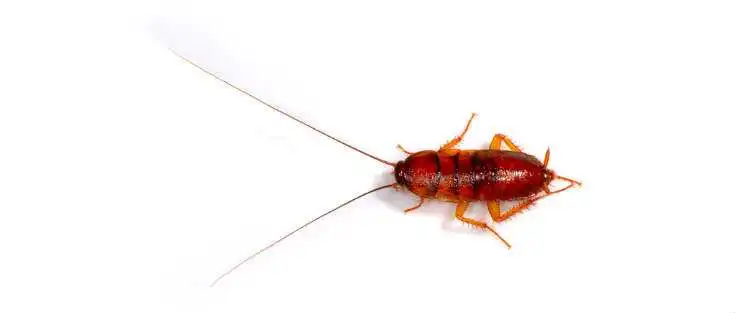
American cockroach nymphs have a reddish-brown color and antennae that may be longer than their bodies.
What Does a Young or Baby Cockroach Look Like?
Baby cockroaches can also look like smaller versions of adult cockroaches. They may have wings and may be a lighter shade of brown than most adults. However, baby German cockroaches are darker than adults and almost black in color.
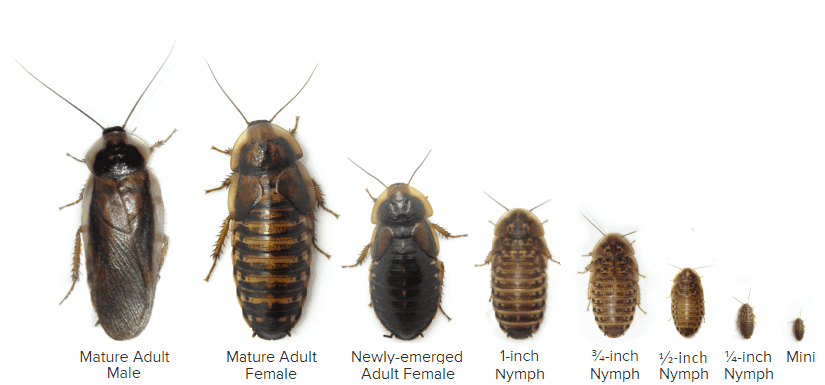
What Does a Grown Cockroach Look Like?
Identifying cockroaches is the first step in eradicating a potentially dangerous infestation. So, what do cockroaches look like?
Adult cockroaches have an elongated oval shape and a flat body, as do juvenile cockroaches. Their heads are small, but the antennae on their heads are extremely long in comparison. Their mouths face downward in an upside-down U-shape.
Cockroaches have six legs with special pads on their feet that enable them to crawl on walls and ceilings. And cockroaches are fast! They can often scurry away from sight so quickly that they are difficult to catch and kill. Some species of roaches have wings that lay flat on their backs, but not all roaches with wings can fly.
The most common species of cockroaches in the U.S. are American Cockroaches, German Cockroaches, Oriental Cockroaches, and the Brown-banded Cockroach.
American cockroaches have a reddish-brown color and grow to be about 40 mm. German Cockroaches are dark brown in color and smaller in size – around 13-16 mm.
Oriental Cockroaches are black and a little bigger than their German counterparts.
Brown-banded Cockroaches are dark brown or black and can be identified by a wide yellow band on their abdomens.
What Do Roach Eggs Look Like?
Knowing what roach eggs look like can help identify a roach nest and stop an infestation before it begins. Female cockroaches lay their eggs in a case called an ootheca. One ootheca can contain many eggs – up to 50 of them!
The eggs are surrounded by a hardened protein substance that protects and nourishes the embryos. Some females will lay their entire ootheca and others will carry it around with them until just before the eggs are ready to hatch.
American Cockroach Eggs
American Cockroaches produce a dark brown ootheca that is approximately 8 mm long.
Female American Cockroaches can lay up to 90 ootheca in their lifetimes and usually keep them well-hidden. Each of the ootheca have around 15 embryos that will hatch between 24 to 38 days.
Oriental Roach Eggs
The female Oriental Cockroach will also produce dark red or brown ootheca that is around 8 to 10 mm long. These cases are a little more rounded and contain around 16 eggs.
A female Oriental Cockroach can lay up to 18 ootheca in her lifetime. This species of roach takes longer to reach maturity after hatching – around 600 days.
Brown-Banded Roach Eggs
The Brown Banded roach ootheca are usually around 5 mm long.
These females can produce up to 20 ootheca in their lifetimes and each case has 10 to 18 eggs. The Brown-banded nymphs are easier to identify because, even at a young age, they have a noticeable yellow band across their upper abdomens.
German Cockroach Eggs
German Cockroach ootheca are brown and around 6 to 9 mm in length.
Their females carry them around in their abdomen until they are ready to hatch.
Each ootheca can contain as many as 50 eggs. Because these roaches produce such high numbers of eggs, this species can reach infestation levels very quickly.
How Long Do Baby Roaches Stay Babies?
Like most insects, roaches molt several times as they mature before reaching adulthood. Nymphs usually hatch between 20 and 60 days. The transition phase between each molting process in called an instar. A baby roach will usually experience 6 to 7 instars before becoming an adult.
Depending on its species and its environment, the molting and instar processes can take between 40 to 160 days.
The Risks Of Having Baby Roaches in The House
More than just a nuisance, baby roaches can also carry diseases and cause widespread allergies and sickness throughout a household. Cockroaches have been found to carry organisms associated with salmonella, typhoid fever, cholera, dysentery, and gastroenteritis. Cockroaches also contain allergies that trigger asthma.
They spread these organisms through their stool, vomit, saliva, and direct contact with their skin. These diseases can spread to humans by breathing contaminated air, touching contaminated surfaces, or consuming contaminated foods. Cockroaches are commonly attracted to household kitchens and bathrooms as they seek out food and water.
How to Get Rid Of Baby Cockroaches and Eggs?
Multiple pesticides and roach killers are available on the market. Consider using a bait station with roach poison. The bait will lure the roaches in, then they will carry the poison back to their nests to help exterminate the roaches more quickly.
Roach pesticide sprays are also available on the market that kills roaches on contact. Although these sprays are effective, it can be difficult to catch cockroaches in time to spray them, as they are such fast runners.
There are a few natural garden pest control alternatives to pesticides such as baking soda mixed with sugar to get rid of baby cockroaches. The sugar’s sweet smell will draw the cockroach to the mixture, then the baking soda will react with its stomach acid and kill it over time.
Bay leaves also attract roaches. They look and smell like food but are poisonous to roaches once they consume the leaves.
Also, cleaning with lemon juice can be a roach deterrent, as they do not like the smell of lemons. Try leaving some lemon rinds in corners or under cabinets, as well.
While these natural alternatives may be preferable to some households, keep in mind that these methods only kill one roach at a time and will not eradicate an infestation.
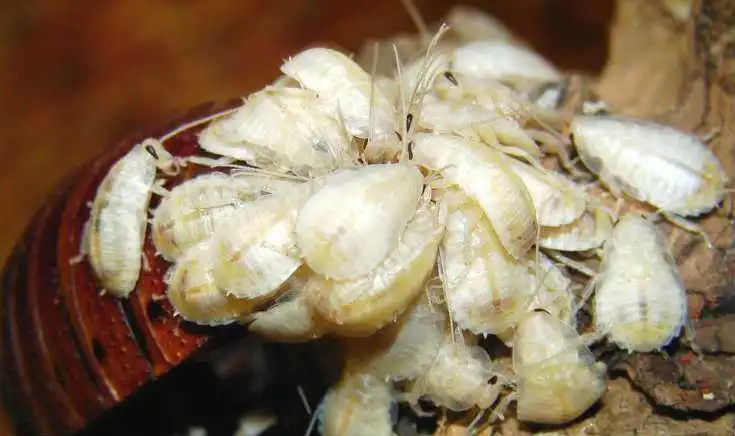
10 Facts About Cockroaches and Roach Eggs
- Cockroaches are in the same family as termites – they both belong to the insect order Blattodea.
- There are approximately 4,500 species of roaches in the world.
- Some studies suggest that German cockroaches have shared intelligence and collective decision-making abilities.
- Female cockroaches are often bigger than their male counterparts.
- Cockroaches eat anything – pet food, plants, garbage, and feces.
- Cockroaches can live without a head for up to one week because they have an open circulatory system that allows them to breathe through small holes in their bodies.
- Roaches can live up to 2 years.
- Cockroaches are present on every continent, except Antarctica.
- Roaches can live up to one month without food.
- Cockroaches can run up to 3 mph.
Conclusion
Cockroaches are more than just annoying bugs. Roach infestations can also be dangerous, as they carry disease and allergens that can make families sick.
Understanding their habits and learning how to identify what baby cockroaches look like can help avoid an all-out roach invasion. Prompt cockroach identification can both prevent an infestation, as well as protect the health of our families.
There may be an even more upsetting pest to set foot in our house and garden, and that is the rat. We have already talked about the best ways to get rid of rats, check it out.
Some would not consider birds and especially pigeons pests, buy they can cause some damage in the garden, and on top of this, pigeons can carry diseases, so it’s a wise idea not to feed them and eventually scare them away.
